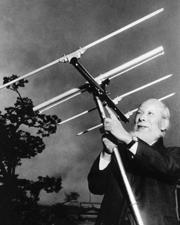Quantum Communication with Nano-Antennas?
Miniaturized television aerials made from gold nanorods could provide a way to control light on a chip — opening up the channels of quantum communication.

If quantum computing networks are ever to become a reality, physicists must find a way to direct and harness the light emitted in quantum experiments. “We must know where and when photons are emitted if we want to collect them efficiently and perform advanced tasks,” says Jason Smith, an expert on quantum nanostructures at the University of Oxford, UK.
Source:Â Nano-antennas could help keep quantum secrets
At the moment, quantum physicists use cumbersome apparatus to try to keep track of photons, for instance, building large vacuum cavities with mirrored walls to guide light. “It’s funny that to control the small quantum world, you need huge pieces of equipment,” says Holger Hofmann, at the Department of Quantum Matter at Hiroshima University in Japan.
Now, Hofmann and his colleagues have developed a way to control the direction of light on the nanoscale. Their technique is based on the workings of the ‘Yagi-Uda’ antenna commonly used to transmit and detect radio waves and often seen on rooftops as television aerials. Hofmann stumbled on the idea by accident, while teaching his electromagnetism class how antennas work. “The textbook didn’t explain it well, and while trying to come up with my own picture, I realized that the same technique could work on the nanoscale.”
Good as gold
A standard Yagi-Uda antenna is made up of a set of parallel metal rods that gradually decrease in length. An electrical signal is fed into the second longest rod, setting it vibrating and producing a driving electromagnetic wave that spreads out in all directions. This stimulates the neighbouring rods to oscillate and emit secondary waves. Both the length and spacing of adjacent rods are carefully set at fractions of the wavelength of the driving wave, so that the secondary waves interfere with the driving wave, amplifying it along the forward direction and reducing it along the sideways and backward directions (see video).
Hofmann and his colleagues realized that gold nanorods should produce the same effect on the nanoscale — but here, the length-to-width ratio of the rods, rather than their length and spacing, is important1.
The team etched their mini gold antenna into a glass substrate and drove it directly with red laser light. The tricky part was to ensure that just one nanorod was driven by the incoming light, just as only one metal rod is in the Yugi-Uda antenna. To ensure this, the team tilted the chosen nanorod by 45º relative to its neighbours and stimulated it using laser light that was polarized at the same angle. They then monitored the direction of light transmitted out of the glass substrate.
The result was actually better than their theory predicted, says Hoffman, with roughly two-thirds of the input light being directed largely forwards2. In their calculations the team had assumed that the nanorods would be fashioned into perfect ellipsoids; in practice, however, they were ‘box-shaped’ and this may inadvertently have improved their performance, Hofmann explains.
Fire at will
Next, the team hopes to integrate the nano-antenna into a silicon chip — a move welcomed by Smith. “It is a huge challenge to make light-control systems compact and efficient,” he says.
The technique may allow material scientists to create efficient ‘single-photon sources’ by precisely controlling the light emitted from nanocrystals called ‘quantum dots’, says Smith. “You could imagine one day being able to press a button and produce a photon on demand.”
Single-photon sources are vital in the field of quantum cryptography, in which quantum processes are used to encode secure information in photons before the data are transmitted. “To have reliability, you really have to know how many photons you are sending out and where,” says Hofmann.
Making the light-control system smaller also enhances the rate of spontaneous photon emission from the source, due to quantum effects, adds Smith. “At the moment, you can produce a photon once every 10 or 100 nanoseconds, but such techniques could improve that to, say, one every nanosecond,” he says. “That would be an important advance.”

Leave a Reply
Want to join the discussion?Feel free to contribute!